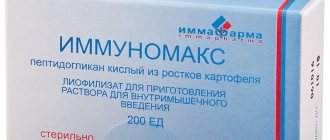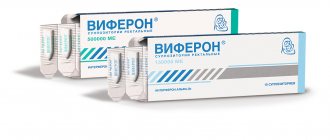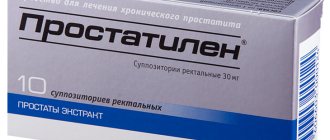- October 16, 2018
- obstetrics and gynecology
- Anatoly Ivanov
In the article we will look at the instructions for use with Flagyl.
For diseases caused by protozoan microorganisms or bacteria, special drugs are prescribed that suppress the vital activity of pathogens. One of the most common medications in this group is the drug “Flagyl”. It has antiprotozoal and antibacterial effects, helps the body cope with pathogenic microflora. Familiarize yourself with the principles of action and indications for use of the product.
The medication is a French-made drug that has antimicrobial and antiprotozoal effects. It is produced by the manufacturer in two pharmacological forms: vaginal suppositories and oral tablets. Flagyl suppositories are packaged in packs of 10 pieces, tablets – in packs of 20 pieces.
Indications for use of the medication
Flagyl tablets are indicated for use in the following cases:
- Protozoal infection, including balantidiasis, cutaneous leishmaniasis, trichomoniasis, trichomonas vaginitis, intestinal amebiasis, trichomonas urethritis, liver abscess caused by amoebas, extraintestinal amebiasis, giardiasis.
- Infections caused by bacteroids, including infections of the central nervous system, bones, joints (meningitis, brain abscess), pneumonia, bacterial endocarditis, pulmonary empyema, lung abscess, sepsis.
- Infections caused by peptococci, clostridia, peptostreptococci, including intra-abdominal infections (peritonitis, liver abscess), infections of pelvic organs, abscess of the fallopian tubes, ovaries, endometritis.
- Gastritis, ulcerative lesions of the duodenum, provoked by the activity of Helicobacter pylori.
- Pseudomembranous colitis, which arose due to the use of antibiotic drugs.
- Prevention of postoperative complications (interventions in the pararectal area, gynecological manipulations, colon surgery, appendectomy).
Flagyl suppositories are often used in gynecology and are indicated for use for the following purposes:
- Prevention of the development of anaerobic infection, likely during surgical interventions on organs in the abdominal cavity and pelvis.
- Local treatment of vaginitis, including trichomonas and nonspecific vaginitis.
Indications for use of Flagyl are described in detail in the instructions.
pharmachologic effect
Antiprotozoal drug with antibacterial activity for topical use in gynecology.
Metronidazole is an effective antimicrobial and antiprotozoal agent with a broad spectrum of action. The drug exhibits high activity against Trichomonas vaginalis, Giardia intestinalis, Entamoeba histolytica, Lamblia intestinalis, as well as against obligate anaerobes (spore-forming and non-spore-forming) - Bacteroides spp. (B.fragilis, B.ovatus, B.distasonis, B.thetaiotaomicron, B.vulgatus), Fusobacterium spp., Clostridium spp., Peptostreptococcus spp., Peptococcus spp., sensitive strains of Eubacterium.
Aerobic microorganisms and facultative anaerobes are not sensitive to metronidazole.
Contraindications for use
The medicine is contraindicated for use in patients who have pathological or physiological conditions such as:
- Age up to 6 years (for tablet preparation).
- Age up to 18 years (for suppositories).
- Liver failure.
- Individual susceptibility to imidazoles.
- Pregnancy.
- Blood pathologies, including information about a history of leukopenia.
- Lactation period.
- Lesions of the central nervous system having an organic etiology.
Pregnancy
Data on the use of Flagyl during pregnancy are limited.
Animal studies have not revealed the teratogenic or fetotoxic effects of metronidazole, but the administration of metronidazole to pregnant women should be carried out with extreme caution. Further research is needed to completely eliminate the possible risks of taking metronidazole during pregnancy
The attending physician can prescribe the drug Flagyl to pregnant women only for health reasons and with constant monitoring of fetal development and the course of pregnancy. Metronidazole is determined in breast milk. If treatment with Flagyl is necessary during lactation, it is recommended to stop (probably temporarily) breastfeeding the baby.
Negative Impacts
When using any pharmacological form of Flagyl, a number of negative reactions may develop, including:
- Increased excitability.
- Weakness.
- Depression.
- Insomnia.
- Irritability.
- Cramps.
- Peripheral neuropathy.
- Ataxia.
- Hives.
- Loss of coordination.
- Skin rash.
- Dizziness.
- Skin hyperemia.
- Headache.
- Nasal congestion.
- Diarrhea, constipation.
- Confusion.
- Fever.
- Epigastric pain.
- Arthralgia.
- Anorexia.
- Dysuria.
- Pancreatitis.
- Polyuria.
- Stomatitis.
- Discoloration of urine in a brownish-red color.
- Cystitis.
- Glossitis.
- Flattening of the T wave on the ECG.
- Loss of appetite.
- Candidiasis.
- Dry mouth.
- Neutropenia.
- Metallic taste.
- Urinary incontinence.
- Nausea, vomiting.
- Leukopenia.
In addition, the use of suppositories can provoke the following undesirable symptoms: vaginal candidiasis, vulvitis, burning in the vagina, increased urination, burning of the penis and a feeling of irritation in the sexual partner.
Composition and release form of the drug
This medicine is available in three forms: tablets, vaginal suppositories and gel for external use. The tablets have a round shape and are covered with a resistant coating, the color of which, depending on the manufacturer, can be white or yellowish. The main active ingredient is metronidazole - each tablet contains 250 mg of this substance. Naturally, other chemical compounds are also used in production. In particular, the drug contains magnesium stearate, wheat starch and povidone. The hard shell of the tablets is made from macrogol and hypromellose.
Doctors often prescribe Flagyl suppositories for the treatment of diseases of the genitourinary system. Suppositories are white or yellowish in color and have a characteristic torpedo-shaped shape. As in the previous version, the active substance is metronidazole, and each suppository contains 500 mg of this component. Solid fat is used as the base for the suppository. As for the gel, its main advantage is higher bioavailability.
Use of the drug
Flagyl tablets must be taken orally.
For the treatment of amebiasis, adult patients are advised to take 500 mg of the drug three times a day for a week.
For the treatment of giardiasis, adults are advised to take up to 1000 mg per day, children 6-10 years old - 375 mg, children 10-15 years old - 500 mg. The duration of therapy is 5 days.
For the treatment of trichomonas urethritis and vaginitis in women, as well as urethritis in men, it is recommended to take 2000 mg of the drug once, or take 500 mg twice a day for 10 days.
For the treatment of nonspecific vaginitis, it is indicated to take 250 mg twice a day. Therapy takes a week.
For the treatment of anaerobic infections, it is recommended to take up to 1500 mg of the drug per day.
If the patient has renal dysfunction, it is necessary to halve the total daily dosage of the drug.
Flagyl suppositories are intended for vaginal administration. Use is permitted only for the treatment of adult women. The correct use of Flagyl suppositories in gynecology involves first releasing the suppository from the shell using scissors and inserting it into the vagina as deeply as possible.
For the treatment of trichomonas vaginitis, it is recommended to administer one suppository per day. Therapy takes 10 days, treatment should be supplemented with the use of tablet medication.
For the treatment of nonspecific vaginitis, it is recommended to administer 1 Flagyl suppository twice a day. If there are indications, treatment is supplemented with the use of a tablet drug.
It is important to note that therapy should be carried out by both sexual partners at the same time, regardless of whether visible manifestations of the disease are present or not.
The use of Flagyl vaginal suppositories is allowed for a maximum of 10 days. The course can be repeated, but not more often than three times during the year.
Composition and release form
Flagyl is produced in tablets of 10 pieces per package. There are usually 2 of these packages per pack.
The main active ingredient is metronidazole.
Indications for use
For the treatment of infectious diseases caused by microorganisms Bifidobacterium, Bacteroides fragilis, Bilophilia, Clostridium perfringens, Clostridium difficile, Eubacterium, Peptostreptococcus, Fusobacterium, Prophyromonas, Prevotella and Veilonella.
Flagyl is effective in the treatment of amebiasis, nonspecific vaginitis, urogenital trichomoniasis, surgical infections, and giardiasis.
Tablets may be prescribed as a continuation of non-oral metronidazole therapy.
Contraindications
Patients with allergic reactions to metrodinazole, its derivatives and any component of the drug should not be prescribed Flagyl.
The use of the medicine is contraindicated in case of sensitivity to gluten, as well as in patients with complex diseases of the central nervous system (there is a high probability of worsening the condition).
The drug should not be used in a weight category of up to 16 kg (usually children under 6 years of age).
It is prohibited to simultaneously take Flagyl and disulfram and/or ethyl alcohol into the body.
With caution, the drug is prescribed to people with blood diseases (including cured ones). During the course of treatment, the patient’s blood condition should be constantly monitored.
Since the drug affects consciousness and vision, operating machinery and vehicles should be postponed until after taking the medication.
Use during pregnancy and breastfeeding
Data on the effect of Flagyl on the course of pregnancy are not fully understood. Therefore, it is recommended to prescribe the drug carefully with regular and careful monitoring of the condition of the mother and fetus. If there is a safer and more researched alternative to Flagyl, it is better to use it.
tends to penetrate into amniotic fluid and breast milk, so it is recommended either to refrain from feeding during the treatment period, or to stop breastfeeding.
Mode of application
Flagyl tablets are manufactured for oral administration.
The dose and duration of treatment are determined by the doctor, based on the general picture of the course of the disease, the patient’s tolerability of the drug, and additional medications that the patient is taking.
Amebiasis is usually treated for a week by taking 500 mg of the drug three times a day. For children, the dose is calculated based on body weight (the daily dose is 30-40 mg per kilogram of weight) The same is taken three times a day.
Giardiasis requires twice taking the drug, 375-500 mg for 5 days. The “children’s” (over 10 years old) dose is 250 mg of the drug.
Trichomoniasis (vaginitis or urethritis) is treated in “children’s” doses with the same frequency of administration for 10 days. At the same time, introducing metronidazole into the vagina while simultaneously treating the partner.
Overdose
With a significant exaggeration of the dose of Flagyl, vomiting, ataxia and disorientation are observed.
There is no specific antidote. Usually, standard techniques are used for intoxication.
Adverse reactions
Flagyl is usually well tolerated without causing adverse reactions.
But some studies of the drug warn of the possible influence of such factors:
- sensory peripheral neuropathy,
- headache, dizziness,
- ataxia,
- convulsions,
- hallucinations,
- confusion.
The digestive system may respond with nausea, vomiting, stool problems, pain, dry mouth and stomatitis.
There is also decreased vision, allergic reactions, and changes in the color of urine.
All cases have reversible consequences and go away on their own.
The occurrence of atoxia, clouding of consciousness and dizziness indicates that it is better to discontinue the drug. If any of the side effects occur, you should inform your doctor and decide on the advisability of further therapy.
Interaction with other medications
With the parallel use of ethanol-containing drugs, their intolerance occurs.
Combining metronidazole with disulfiram increases the likelihood of developing a variety of neurological abnormalities. In this regard, a two-week interval should be maintained between courses of therapy with these drugs.
When used together with indirect anticoagulants, their effects are enhanced, resulting in an increase in prothrombin time.
Simultaneous use with cyclosporines and lithium drugs causes an increase in their concentration in the blood plasma.
Cimetidine has the ability to suppress the metabolism of metronidazole, resulting in an increase in its serum concentration and a sharp increase in the risk of developing negative symptoms.
The excretion of metronidazole increases, resulting in a decrease in its concentration in plasma, if stimulants of microsomal liver enzymes (phenobarbital, phenytoin) are used in parallel.
Important Features
Alcohol combined with Flagyl increases the risk of side effects. Nausea and even vomiting, increased heart rate, and increased body temperature may occur. Therefore, alcoholic beverages are avoided during treatment.
If you have to take the medicine for a long time, you need to monitor your blood counts. Leukopenia may develop.
Since the antibiotic Flagyl reduces concentration, you should not engage in activities that require increased attention. You cannot drive a vehicle.
If neurological changes occur while taking the medication, then use of the drug should be discontinued.
After the effect of Flagyl in the body ends, the medicine is excreted by the kidneys. In this case, you may notice that the urine has turned brown.
Positive reviews of the drug note its effectiveness and quick response. Negative reviews are associated with the occurrence of side effects. Nausea and diarrhea very often develop.
If for some reason the drug cannot be used in the treatment of parasites, then analogues, which also contain Metronidazole, can be prescribed. You cannot make the replacement yourself. The most common analogues include: Trichosept, Metronidazole, Trichopolum, Metrogyl, Rozamet, Efloran.
Trichopolum is often used as a replacement. The medicine is prescribed for the treatment of infections caused by protozoan microorganisms. Has antiprotozoal effects. Compared to other analogues, it has a low cost
Should be used with caution, as the components negatively affect the intestinal microflora and cause a large list of adverse reactions.
Special instructions for use
If Flagyl therapy is long-term, it is recommended to periodically examine blood counts. If leukopenia occurs, it is necessary to consider the advisability of further use of the drug, since there is a high probability of developing an infectious lesion.
Therapy should be discontinued if the patient experiences dizziness, hallucinations, ataxia, or if his neurological condition has significantly worsened.
During the treatment of trichomonas vaginitis in women and men's trichomonas urethritis, it is recommended to abstain from sexual intercourse. Therapy should not be stopped during menstruation.
It is important to consider that metronidazole has the ability to immobilize treponemes, as a result of which there is a possibility of obtaining a false positive result when performing the Nelson test.
Description of the drug
The most common disease that people encounter is helminthiasis. Parasites, penetrating the body, begin to disrupt the functioning of internal organs and entire systems. Absorb all nutrients, including vitamins and minerals necessary for normal development. The immune system weakens and resistance to any infection weakens.
The medicine Flagyl for worms will help fight the invasion of pathogenic bacteria and strengthen the defenses of the immune system.
The drug Flagyl has antiprotozoal and antimicrobial effects. After administration, the active substances begin to interact with the DNA of the pathogenic microbe. The result is the destruction of its structure, and bacteria are not capable of further reproduction.
What can these tablets be prescribed for? The medicine is effective against many pathogens of infectious diseases, such as clostridia, lamblia, eubacteria, streptococci, peptostreptococci and many others.
Within an hour after taking the tablet, its maximum effect begins. The components are absorbed almost completely, 80%. Then there is a rapid distribution throughout the body. Eating does not affect the absorption of medicinal components.
In addition to the tablet form, the medicine is produced in the form of vaginal suppositories, suspensions, powder for solution and gel. Light yellow Flagyl suppositories contain 500 mg of active ingredient. One pack includes 10 pieces. Flagyl gel is used vaginally.
An antibiotic can be bought at a pharmacy only with a doctor's prescription for approximately 100-150 rubles. Candles cost around 600 rubles.
Analogues of Flagyl candles
The main analogues are the following drugs: “Funginal”, “Ketoconazole”. ""Neo-Penotran", "Clotrimazole", "Micogal", "Candide", "Livarol", "Candibene", "Tinidazole", "Zilain", "Nitazol", "Ginofort", "Atrican", "Ginalgin" . Synonyms of “Flagyl” are: “Siptrogil”, “Efloran”, “Metrogil”, “Trichobrol”, “Metronidazole”, “Klion”, “Gravagin”, “Trichopol”, “Batsimex”.
It is important to consider that all of these drugs have some contraindications; they can cause negative symptoms. Therefore, it is important to discuss the possibility of changing the drug with your doctor.
How much does the drug cost?
For many patients, the issue of cost is a top priority. So how much does Flagyl cost? The price in this case may vary depending on the form of release, the financial policy of the pharmacy, as well as the manufacturer. Indeed, today many pharmaceutical companies in the USA, France, Czech Republic, Switzerland and other countries are engaged in the production of this medicine.
How much will the medicine “Flagyl” (suppositories) cost? The price of vaginal suppositories ranges from 200 to 350 rubles for 10 suppositories. The cost of the tablet form of the drug is slightly lower - for twenty tablets you will need to pay about 150-200 rubles.











